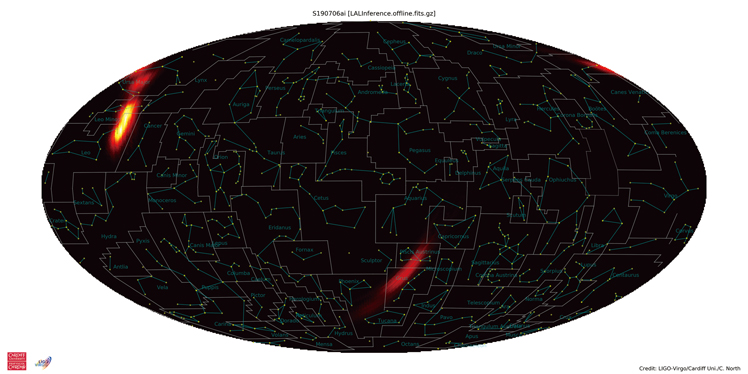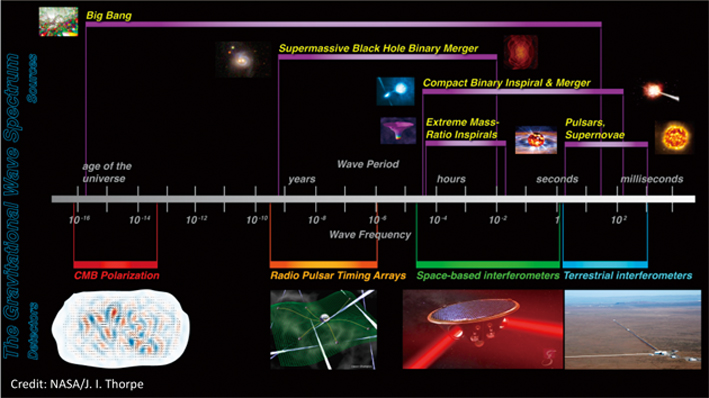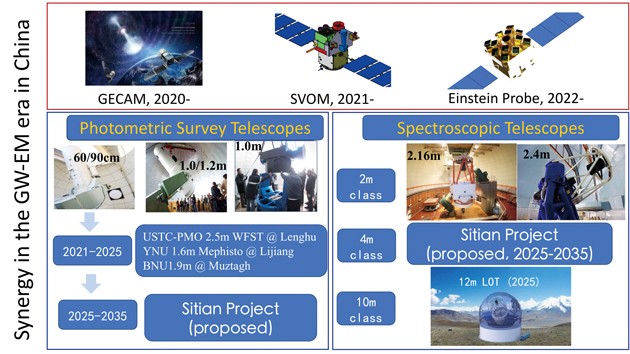By SONG Jianlan (Staff Reporter)
Discovery of gravitational waves is not the end of search, but the beginning of a new era.

An artist’s illustration of GW170817, a gravitational wave event detected by LIGO-Virgo coordination, the alliance between Laser Interferometer Gravitational-wave Observatory and Virgo Interferometer on Aug 17, 2017: Two neutron stars merged and simultaneously set off gravitational and electromagnetic waves, including visible lights. This detection aroused a grand wave of coordinated observations around the world, hailing an era of multi-messenger astronomy. For a long time, humankind basically had only electromagnetic signals to lean on when observing the cosmos. With the aid from gravitational waves, the newly found messenger, astronomers and physicists are expecting to reconstruct a clearer picture of the cosmos. (Credit: NSF/LIGO/Sonoma State University/A. Simonnet)
It has been almost four years since LIGO, the Laser Interferometer Gravitational-wave Observatory’s first successful detection of a gravitational wave (GW) event – the merging of two black holes. This ground-breaking experiment eventually verified the existence of these space-time ripples as predicted by Albert Einstein. Nowadays, one can still hear and feel the rippling waves in the seemingly quiet cosmos – particularly in the astrophysical community. Apart from more GW sources, astrophysicists are searching for more electromagnetic (EM) counterparts of GW events; more importantly, through these weak, faint signals, they are seeking to understand how the universe works – including but not limited to testing Einstein’s general relativity (GR) with observations on such extreme phenomena.
New Wave of GW Observations
On the bankside of the lake Dianchi in Kunming, a southwestern city of China, physicists and astronomers from different parts of the secular world were sharing their ideas and latest progress in GW observations and related physics at a meeting titled “Gravitational Wave Astrophysics Conference 2019”1.
At the meeting, Prof. WEN Linqing, who joined LIGO over two decades ago, gave an invited speech on the discovery of GWs and the later detections of different GW sources by LIGO and its ally, Virgo Interferometer located at the European Gravitational Observatory (EGO) in Italy. Particularly, she gave an overview of the on-going wave of observations, the third observing run (O3), made by this international scientific organization.
According to WEN, this new wave of observational activities lasts from April 1st, 2019 to April 30th, 2020, with a one-month break in October 2019. After series of upgrading and joining hands with Virgo, now the LIGO-Virgo coordination has reached a new high of sensitivity, capable of detecting much more distant and weaker signals. So far, LIGO-Virgo has issued 27 open public alerts to GW detections (candidate GW events). Four of them were retracted, leaving 23 valid candidates for further follow-up observation and analysis.
These alerts have excited a new wave of observing efforts all over the world, feeding hope for new detections of merging binary neutron stars or hybrid binaries of black holes and neutron stars – in that case EM waves will burst out in the wake of the GW oscillation. People are anticipating a recurrence of the grand globally coordinated observation triggered by GW170817, the first and the only-so-far binary neutron star coalescence picked up by LIGO-Virgo. Unlike those mergers between black holes, such type of binary coalescences simultaneously give off GW and EM signals, making it possible for “conventional” telescopes working in EM bands to follow their trails. Resulting from that global synergy of observations, a gamma-ray burst (GRB) was found to be associated with GW170817 and identified as its afterglow (and named GRB170817a); its counterparts in other EM bands, including visible lights and X-rays, were also found out.
Exactly on the opening day of the meeting, LIGO-Virgo detected an interesting GW source and gave an alert. The GWs seemed to have been triggered by the coalescence of a black hole and a neutron star – the participance of the latter in the binary system would mean EM signals given off from the merger and hence possibility to be picked up by the large number of conventional telescopes all over the world. Yes, humankind has so far built very limited number of GW detectors, but has been familiar with observations in the EM world for a long enough time. The community has been excited by this news, though cautious enough to allow some room for the possibility that the smaller one in the pair could also be a small black hole – in that case, no EM signal would be set off, as believed by most astrophysicists.
Coordinated Searching for More GW Sources
Amid the renewed excitement fueled by observations of O3, the detection of more GW sources stood out as probably the most attractive issue for participants of the meeting: How can we detect them? How can we detect them in a more efficient, more reliable and more accurate way?
Dr. Rana Adhikari, who is with LIGO team at California Institute of Technology (CalTech), gave an invited speech on multi-band quantum interferometry combining terrestrial and space GW detectors. “Leaving it to terrestrial observation alone would be impossible,” he said, asserting the importance of coordinating detectors on the earth and in space to detect more GW events in a wider range of frequencies. The complexity of noise would pose a great challenge on ground-based observation; while Earth-space networking would offer super angular resolution, he concluded.
Prof. David Blair, founder and former director of the ARC Centre of Excellence for Gravitational Wave Discovery (OzGrav, formerly Australian International Gravitational Research Centre) and Emeritus Professor at the Western University of Australia, has been engaged in GW observation and research for decades. Having earned great prestige in research on observing methods of GWs, he has been elected a Member of the Australian Academy of Sciences. He authored the book Ripples on a Cosmic Sea: the search for gravitational waves nearly two decades before LIGO’s discovery of GW, and this book is now listed first on LIGO’s booklist of GW. In his talk, he introduced new concepts for a broadband high-frequency gravitational wave detector. Using white light signal recycling, this new design enables broadband resonance to amplify the GW signals, and hence improves the sensitivity needed for studying the physics after the merger. This concept is compatible with LIGO’s design, he introduced; and his team would like to develop this concept into an expandable network in Asia-Australia region. In that case, he said, the detector will make a very good contribution to the angular resolution of the worldwide GW detector array. “We are very keen to work with our friends in China to develop concepts because Australia does not have the resources to build a detector on its own,” he said.

LIGO-Virgo’s third observing run (O3) has been going on for five months. The open public alerts of its detections have encouraged observatories of different bands over the world to join in, with new hope of finding EM counterparts of GW sources. Shown here is a sky-map showing the likely (90%) location of gravitational-wave source on the sky for an event that detected by the coordination on July 6, 2019. (Credit: LIGO-Virgo/Cardiff Uni./C. North)
The Kamioka Gravitational Wave Detector (KAGRA), a Japanese underground GW observatory in construction, will become the first GW detector in Asia. Dr. Shinji Miyoki from University of Tokyo introduced the current status of the project, with detailed description of its design and prospect strengths. Built underground, this detector can secure stable operation in low seismic noise; and its design of suspended cryogenic mirrors can reduce thermal noise. KAGRA is set to join O3 of LIGO within this year. “We need more detectors to improve localization of GW sources,” he said, when explaining the necessity of building KAGRA. A network observing in synergy would improve the localization and pointing precision; also, the detection would be more convincing compared with those made by independent observatories, he remarked. KAGRA is an international collaboration involving over 450 cooperators. Working with the team are 65 scientists from a number of Chinese institutions, including several observatories and research institutes under CAS.

Detection and research of GW sources of different frequencies will help us better understand the cosmos in which we live. (Credit: NASA/J. I. Thorpe)
Taiji, a space GW observatory proposed by CAS and designed to launch around 2033, might represent a Chinese voice in the chorus. Consisting of three component spacecraft, Taiji is to form an equilateral triangle flying 18 to 22 degree ahead of the Earth orbiting around the Sun. Its baselines span a distance of about 3.0 million km.
Prof. Wei-Tou Ni, who works for both the National Astronomical Observatories, CAS (NAOC) and the Wuhan Institute of Physics and Mathematics (WIPM), Innovation Academy for Precision Measurement Science and Technology (IAPM), CAS, reported the progress of Taiji on behalf of the Taiji alliance. The designed sensitivity and working frequency band of Taiji aims at bridging a gap on the frequency spectrum for GW observation. Prof. Ni also gave a detailed technological analysis for its possible joint observation with another space GW observatory, the Laser Interferometer Space Antenna (LISA). Led by the European Space Agency (ESA), LISA is being developed by ESA and NASA, and will launch around 2034. If the two could join hands in space, the baseline of the array would be greatly extended, and hence greatly improve the sensitivity of observation, as well as the accuracy in determining the position of the detected GW source.

Prof. David Blair introducing his concept of a new GW detector. (Photo by SONG J.)

Angular accuracy improves with extended baselines: shown here on the sky-map is localization of some GW sources detected by LIGO and later LIGO-Virgo. The two sources detected by LIGO-Virgo coordination, namely GW170814 and GW170817, are constrained to much smaller areas in the sky, illustrating greatly improved angular accuracy due to the extended baseline of LIGO-Virgo coordination compared to LIGO alone. (Credit: LIGO/Virgo/NASA/Leo Singer; Milky Way image by Axel Mellinger)
Embrace the Era of Multi-messenger Astronomy
The prospects of detecting more EM counterparts of GW sources – the EM profiles left behind by those cosmic events that simultaneously radiate GWs and EM signals – have greatly encouraged scientists working with conventional telescopes. They are upgrading instruments and formulating optimized strategies to detect more of such events at better accuracy. Some reported their progress at the meeting.
Among them, are Chinese scientists and institutes.
Under the umbrella of its Pilot B program, CAS is making efforts to “listen” to the EM whispers of GW sources. Some of its existing telescopes have made contributions to multi-messenger astronomy already. For example, the Insight-HXMT satellite joined the follow-up observation synergy on GW170817, only two months after its launching, and helped constrain the radiative properties of the source in high-energy (MeV) range. Its FAST, the largest telescope in the world that is still being debugged to meet designed observational performance, has already displayed its great potential in identifying pulsars in large numbers. These celestial bodies can work as a timing array in interstellar navigation, because their pulses are extremely stable – far more accurate than the quartz oscillation in an atomic clock – and hence can be used to calibrate the travel distances and speeds of a spacecraft or a GW/EM signal.
The network of ground-based optical telescopes under CAS also participated in the synergy of observations on GW170817. Particularly, the AST3-2, a 50cm-aperture telescope built by CAS at the Kunlun Station of the Antarctica successfully picked up the visible-light signals from this neutron-star binary, producing important data.
Also, the academy is building new facilities to better hear the EM whispers from such violent cosmic events in distance. Among them are the Gravitational wave high-energy Electromagnetic Counterpart All-sky Monitor (GECAM), and the Einstein Probe (EP). The two, and the Space-based multiband astronomical Variable Objects Monitor (SVOM), a joint mission of the China National Space Administration (CNSA) and the French Space Agency (CNES), are all to launch in the next few years.
Proposed in 2016, introduced Prof. XIONG Shaolin, principal investigator of GECAM, the mission will fly just in 2020, and perform all-sky monitoring to detect high-energy electromagnetic counterparts of gravitational wave events, mainly X-rays and gamma-rays, termed “Gravitational Wave Gamma-Ray Bursts (GWGRB)” for short. It encompasses two micro-satellites orbiting at an altitude of 600 km above the Earth, in combination they will cover the whole sky and hence be able to perform full-sky monitoring to capture gamma-ray bursts from mergers of binary neutron stars or a black hole and a neutron star.
Named after Einstein, EP has targeted those astronomical phenomena predicted by this scintillating physicist, particularly EM outbursts from GW events and black holes. According to Prof. YUAN Weimin, principal investigator of EP, this space-based observatory will be the only one working in soft X-ray bands for such targets in the visible future. Equipped with its lobster-eye micro-pore optics (MPO), an advanced X-ray focusing imaging technology, it will achieve an unprecedentedly high sensitivity, and will be capable of detecting transient X-ray sources much darker and farther away than ever, including the predicted, elusive X-rays from GW events.
In vision working to this end is also a large-scale terrestrial array called Sitian program proposed by NAOC. It aims to build a network of optic telescopes in China to observe EM counterparts of GW sources. On the other hand, astronomers are seeking to establish some observing consortium in EM bands, to meet the demand for follow-up observations in response to LIGO’s O3 detections.

With its future space and terrestrial observatories working in EM bands, CAS is deploying an observing synergy in the era of multi-messenger astronomy. (Credit: CAOC)
GW Physics
It might be hard to say what would be the most important science question for the era of multi-messenger astronomy. However, it might be much easier to agree that our astronomy never stops at observation.
At the meeting, a significant number of participants shared their models and theories of compact star binaries. At what conditions could a merger be triggered, and at what point would it exactly begin? How the GWs would change in the merging process? How the mass ratio of the pair could influence the merging process as well as the GW emission? At what point of the merging would GWs be given off and how the waves would propagate? Was Einstein right concerning the wave forms at different stages of the merging? At what situation could the merger product explode and become a kilonova, and at what situation would the merger lead to a collapse and hence give birth to a black hole? Could the merger of two neutron stars produce jet flows? …
Scientists tried to figure out the physical laws behind GWs, and test existing models and theories that predict stellar evolution or describe the early history of the cosmos. Among them, Prof. CHEN Yanbei from CalTech compared the observed properties of binary black hole mergers and predicted effects derived from GR in his talk to test the consistency, “breaking down” GR. Prof. Matthew Bailes from OzGrav tested gravity with binary pulsars and the equation of state of nuclear matter in his speech, outlining properties and evolution of pulsars, as well as physics in pulsar timing.
Some paid more attention to the EM counterparts of GWs. Among them were Prof. ZHANG Bing from University of Las Vegas and Prof. WEI Daming from the Purple Mountain Observatory, CAS.
Some sought to find out the potential connections between the detected GW sources and EM events – those once seemed irrelevant might turn out to be in association, or even be different facades of the same architecture. Combining different information from different “messengers”, scientists might be able to reconstruct a better picture of our universe.
Prof. Rainer Spurzem, a professor from Heidelberg University working at the National Astronomical Observatories, CAS (NAOC), are among those who simulated the formation of black-hole binary systems before LIGO’s first detection of GWs. His team is now trying to find out how the cosmos evolve via black hole dynamic simulation, drawing on data from past observations in GW and EM bands.
Prof. Spurzem first came to China in 2012, encouraged by the country’s progress in supercomputing technology. His team is now using a supercomputer situated on the campus of NAOC. “With a supercomputer, we have much better a way to see what happens. When observing in LIGO or other telescopes, we just make some snapshots – we just see something for a short time. But you need to follow the evolution using physical laws over many million years, unless you cannot know how it’s developed. Or we would like to find how black holes are produced, how they formed. How did it start? With observatories we just know it happens this place, this time; with computers we can figure out how it happened, and how it stopped.”
“It’s like basic research,” he further explained: “We are interested in what happens in the universe. One of the goals is to test the most important findings of Einstein, like black holes. If you can detect them in some way, then it should be done now.”
Concerning the evolution of compact star binaries, including black-hole, neutron-star and hybrid binary systems, still we need to improve our understanding of its physical process, said Prof. LU Youjun, chair of the conference scientific organizing committee and principal investigator of the research group for gravitational-wave astrophysics at NAOC. Merging of such systems, said LU, provides us with a unique “lab” to look at the structure of such compact stars, the radiation processes adjacent to the event horizons of black holes, and to test physical models for black hole and gravitational waves. Combining GW and EM observations of the same events could provide us better opportunities to figure out physical laws underlying these phenomena.
Discovery of GWs is not the end of the search; it is the beginning of a new era.

